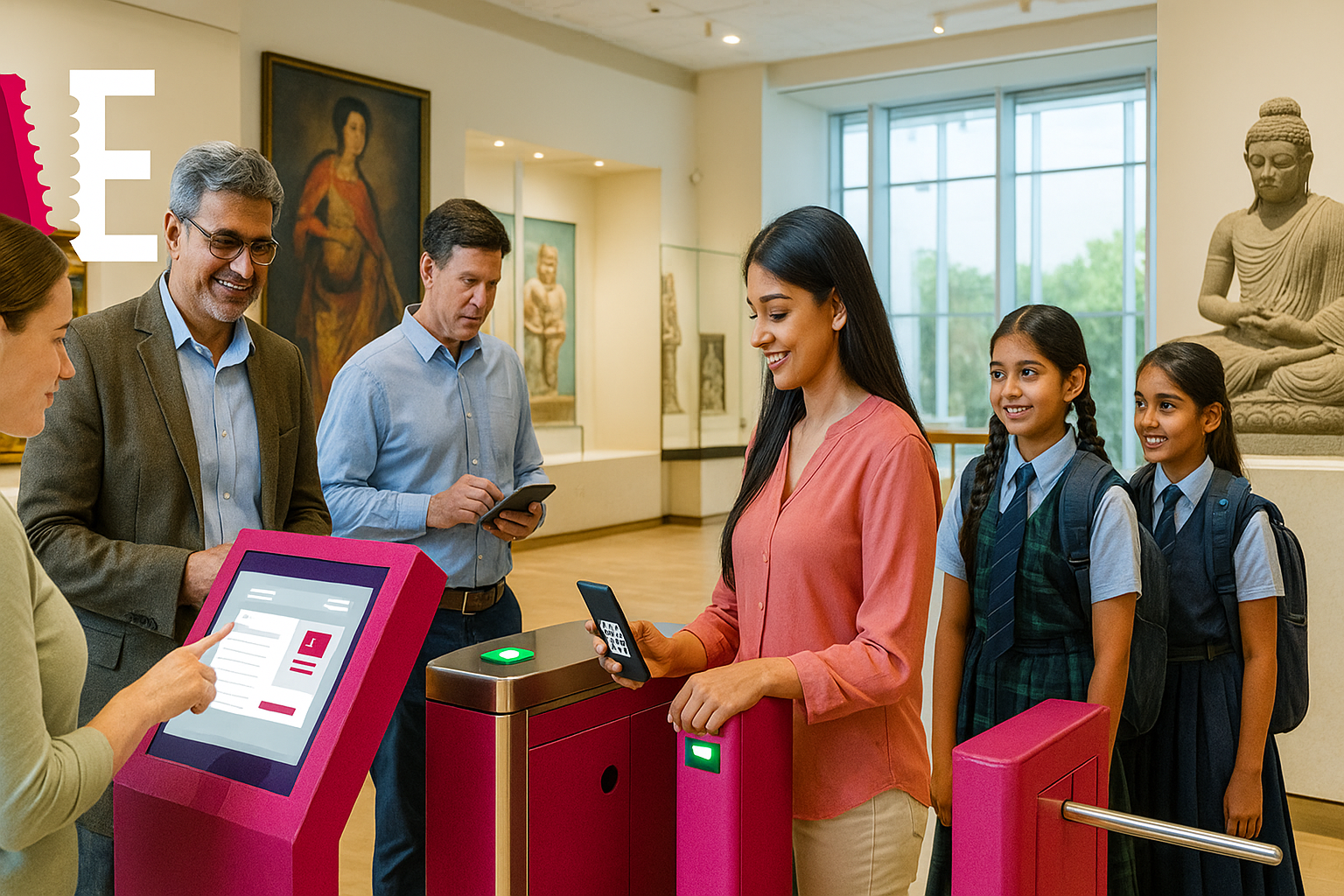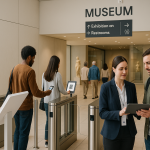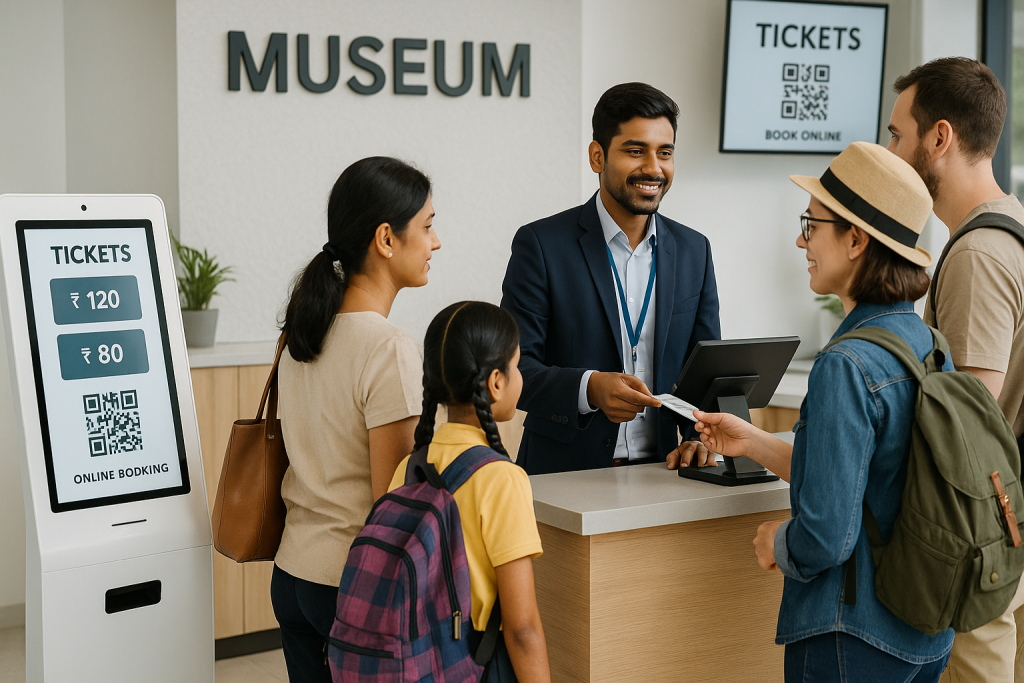A proper ticketing software for museums. Especially in 2025.
Hello, museum operator, curator, or just someone who’s tired of paper tickets and endless queues, this is for you.
Let’s talk about something that feels overdue (like an unpaid invoice):
A proper ticketing software for museums. Especially in 2025.
Because right now, if you’re still doing things manually printing tickets, jotting visitor names on a logbook, chasing cash slips, you’re not just losing time.
You’re probably losing revenue.
And worse, you’re missing out on valuable visitor data that could actually help grow your museum.
2025 isn’t the future anymore.
It’s here.
And if you’re running a museum, big or small, now’s the time to switch to something that works smarter than spreadsheets and sharpies.
Hidden Cost of Manual Museum Ticketing
Let’s be real, manual ticketing isn’t just “old-school.”
It’s broken.
Long queues at the counter? Visitors hate it.
Paper stubs that get lost or torn? You hate it.
Revenue that doesn’t quite match the number of heads walking in? Yeah… no one likes that.
But it’s not just about inconvenience, it’s about leakage.
Leakage of time.
Leakage of money.
Leakage of insights.
Because here’s what happens when you don’t use a proper museum ticket POS or digital system:
- Tickets sold at the gate don’t get tracked
- Walk-ins are recorded manually (with errors)
- You have zero idea about peak times, visitor types, or repeat visits
Basically, you’re flying blind and hoping for the best.
In 2025, that’s not good enough.
Especially when there’s tech out there that solves all of this… without eating your budget.
What Makes 2025 the Tipping Point for Digital Ticketing?
Let’s zoom out for a second.
Why now? Why 2025?
Well, a few things have quietly shifted and together, they’ve made digital ticketing not just nice to have, but kind of essential.
First: Visitors today expect things to be digital.
Post-COVID, people got used to contactless check-ins, QR codes, and online bookings and they’re not going back to paper slips and cash counters.
Second: Smartphones are everywhere.
Even in smaller towns and heritage cities, your visitors are scanning codes, booking experiences online, and sharing them on social media.
Third: Governments and tourism boards are pushing hard for digital transformation and museums are directly in the spotlight.
There are grants, tech-friendly mandates, and rising pressure to show transparency in visitor data.
So yeah, 2025 museum ticketing solutions aren’t just tools.
They’re expectations. From your visitors. And your funders.
What is a Museum Ticketing Software and How Does It Work?
Alright, let’s break it down.
Museum ticketing software is exactly what it sounds like, a digital system that helps you sell, scan, and manage tickets for your museum.
But it’s more than just a digital counter.
Here’s what it usually includes:
- Online booking (so visitors can buy tickets from your website or phone)
- QR code scanning at entry (no need for paper or physical counters)
- A lightweight CRM that tracks who visited, when, and how often
Think of it like your front desk… but way faster, smarter, and open 24/7.
Most modern systems also include a museum ticket POS, which is just a fancy way of saying “you can still sell tickets at the gate but digitally.”
Want to see how all that works together?
Here’s a helpful read: Museum ticketing POS & online booking guide
Top Benefits of Using a Digital Ticketing System for Museums
Okay, so we’ve talked about the “why.”
Now let’s get into the “what’s in it for you.”
Here’s what switching to a digital ticketing solution for museums actually unlocks:
- Online ticketing = No more missed sales. Visitors can book anytime, from anywhere.
- QR code check-ins = Entry is faster, queues are shorter, staff is less stressed.
- Real-time data = Know how many people walked in today, and how many might come tomorrow.
- Less leakage = Digital records = less cash mishandling or missing tickets.
- Built-in CRM = Track repeat visitors, group bookings, school trips — all in one place.
- Reports that make sense = Get daily or monthly reports without touching Excel.
All of this makes digital systems the best museum ticketing software for teams that are small but ambitious.
Because running a museum is hard enough.
Your ticketing system shouldn’t make it harder.
EveryTicket – India’s Purpose-Built Ticketing Software for Museums
Let’s cut to it, there are a bunch of tools out there.
But most of them? Built for big events. Or global stadiums. Or amusement parks.
EveryTicket is built differently.
It’s made for Indian museums. Specifically for small to mid-size operations that don’t have a 10-member tech team or the budget for one.
Here’s what makes EveryTicket actually work:
- QR-based digital tickets (paperless and quick)
- POS + online setup (sell tickets at the gate and online)
- Regional language support (because not every visitor reads English)
- CRM & visitor tracking built-in
- Works even in low-connectivity zones
Oh, and we recently launched on Product Hunt. Out of 265 products, we ranked #21 — not bad for a software quietly built for real-world problems.
Curious to see it in action?
Request a live demo here — we’ll show you how it fits your museum.
What to Look for in the Best Museum Ticketing Software in 2025
If you’re shopping around for tools, here’s a simple checklist to avoid wasting time (and money).
Easy setup
You shouldn’t need an IT team to get started. Plug & play matters.
POS + online support
Look for something that handles both gate sales and online bookings seamlessly. No visitor left behind.
Mobile-friendly
Your staff should be able to use it from a phone or tablet. Bonus points if it works offline too.
Visitor data & reports
Daily reports, visitor logs, revenue tracking, the basics should be built-in.
Support for regional use cases
Not all museums are in metros. Not all visitors use English. The tool should get that.
This is exactly where 2025 museum ticketing solutions are headed tools that feel custom-built for you, not just scaled-down versions of something built for mega-venues.
How to Transition from Manual to Digital Ticketing – A Starter Plan
Now, you might be thinking:
“This all sounds great… but how do I even start?”
Good news: You don’t need to flip your system overnight.
Here’s a simple 3-step plan to help your museum move from manual to digital, without chaos.
Step 1: Start Small
Try the Starter Plan — ₹3K/month gets you:
- Up to 500 tickets/month
- Support for multiple payment methods
- Basic analytics (real-time!)
- 5 active staff accounts
- And yep — staff training is included
Step 2: Add What You Need
Want to sell at the gate too? Add the POS system for ₹2K/month.
Need a kiosk setup? That’s ₹3K/month — still super lean for museums running on tight budgets.
Step 3: Go Live & Learn
Your staff gets trained. Visitors get faster check-ins.
And you get data that helps you plan school events, time slots, peak hours, all in one place.
Switching doesn’t have to be scary.
Just start smart.
Final Thoughts – Digital Ticketing Is No Longer Optional
Here’s the truth:
Running a museum is hard work. Your ticketing system shouldn’t make it harder.
Whether you’re dealing with long queues, revenue leakage, or just tired of paper slips, 2025 is the year to make the switch.
Start small. Go digital.
And if you’re curious to see how it all works in real time…
Fill out the inquiry form and request your live demo here
Let’s make your museum ticketing smart, simple, and future-ready.
FAQs
1. What is the best ticketing software for small museums?
Look for tools like EveryTicket — simple, affordable, and made for cultural spaces, not concerts.
2. How does a museum ticket POS work?
It lets you sell tickets at the gate using a phone or tablet with real-time tracking and digital receipts.
3. Can it work without internet?
Yes. EveryTicket supports low-connectivity zones syncs up when the network is back.
4. Is it hard to train staff on this?
Not at all. Staff training is included in the Starter Plan, and most team members get it within an hour.



